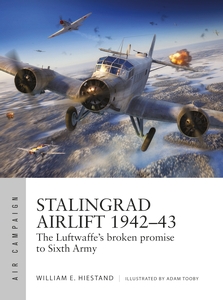
From the day the last remnants of Paulus’ Sixth Army surrendered in the ruins of Stalingrad, Luftwaffe officers ascribed the failure of the air supply effort to the size of the force to be supplied, the limited number of transports, and the poor weather. Opposition from the Soviet Air Force was considered at most a secondary factor. Despite Luftwaffe officers at the time and after the war downplaying its impact, however, my research for the Osprey Air Campaign volume ACM 34: Stalingrad Airlift 1942–43 revealed that the Soviet Air Force won the air battle for Stalingrad as much as the Luftwaffe lost it. At Stalingrad, the Soviet airmen established an air blockade that included radar-directed fighter interception zones, a ring of anti-aircraft artillery, and a sustained effort to bomb Luftwaffe bases both outside and within the pocket. The Ju 52s and He 111s flying in supplies were soon forced to fly only at night or in cloudy conditions. The demands on the Luftwaffe’s limited numbers of fighters, Stukas and bombers were so intense that it could never overcome Soviet opposition by suppressing the anti-aircraft positions, attacking enemy airfields, or even successfully escort its own transport flights.
Leadership and command and control gave the Soviet Air Force a decided edge over the Luftwaffe at Stalingrad. After promising Hitler that his air force could do the job, Reichmarshal Goering absented himself from day-to-day management of the airlift, and immediately departed on his private train to shop for art in Paris. In contrast, the Soviet Air Force Commander-in-Chief, Alexander Novikov, had been on the scene since late August, leading a special staff element from Air Force headquarters and coordinating the actions of the 8th, 16th, and 17th air armies and bombers of Long Range Aviation operating around Stalingrad. After Novikov’s reorganizations in early 1942, Soviet air power was no longer shackled to individual combined arms armies, and he was able to move forces to cover different missions as needed. This flexibility allowed Novikov to shift forces from the 8th, 16th, and 17th armies to simultaneously blunt the Winter Storm relief attempt, maintain the air blockade, and support the Little Saturn offensive that shattered the Italian Eight Army in December.
The Soviet Air Force had also improved on the tactical level by late 1942. Soviet pilots increasingly adopted the effective German ‘schwarm’ (finger four) two- and four-plane formation rather than the rigid and vulnerable three-plane katte of 1941. More and more VVS aircraft now had full radio sets, and the radar and radio control network established just behind the front line proved adept at guiding Soviet pilots to their targets. Novikov formed elite units such as the 9th Guards ‘ace regiment’ to engender a new aggressive spirit in the Soviet Air Force.
A key factor in the Soviet Air Forces’ success at Stalingrad was the employment of its Il-2 Shturmovik force. For the first time, Shturmoviks were employed in large numbers, with 575 available at the start of the Uranus offensive on November 19th that encircled the Sixth Army. The Il-2 pilots employed improved tactics learned at high cost during the first year of the war, including shallow dives to increase accuracy. Armoured against ground fire but vulnerable to fighter attacks from the behind, the Shturmoviks also took measures to improve their defensive capabilities; at first with improvised rear-gunner positions and later with factory-produced two-seat models. The Pe-2 light bomber force also began to use dive-bombing techniques to improve accuracy. The Il-2s and bombers both supported Red Army operations on the ground and conducted frequent raids on the key Luftwaffe air bases during the campaign.
While the campaign was successful, the cost in Soviet aircraft and aircrew remained high. The Luftwaffe was likely able to bring down at least three Soviet aircraft for each one it lost, and its ‘Experten’ aces added more victories to their tallies. The Soviet Air Force continued to push pilots and aircrew with minimal flight training into the front line and these novices were easy victims for the German veterans. But, while the Soviets lost aircraft and aircrew in large numbers, the USSR was able to keep its units up to strength. Aviation factories had been safely evacuated to the Urals and were producing at high capacity in 1942, with 25,436 aircraft produced during the year. Germany only produced 15,596, and the Luftwaffe would need many of these aircraft to defend the Reich against the allied combined bombing offensive and for other theaters. The staying power of the Soviet Air Force was reflected in its high operational rate – 35,920 sorties by Soviet aircraft during the Stalingrad counteroffensive phase (19 November 1942 to 3 February 1943), as against 18,500 German.
The Stalingrad campaign and the Luftwaffe’s failed airlift marked the moment when the German war machine, built for short, decisive, and successful offensives, was decisively defeated by an opponent willing to engage in a costly and protracted campaign of attrition. The Luftwaffe would still be able to mass its forces and challenge the VVS for the next few years, but Novikov’s airmen were on the path that would lead to victorious Shturmoviks flying over the ruins of Berlin two years later.
If you enjoyed today's blog post, you can find out more with the book here.

Comments
You must be logged in to comment on this post. Click here to log in.
Submit your comment